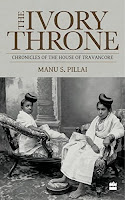Book Review : The Ivory Throne by Manu S. Pillai (Rating ****)
This book
specifically concentrating on the history of Travancore kingdom, a southern
part of Kerala, also gives in-depth information of general history of Kerala,
The famous Zamorins, The Vasco Da Gama etc. The story starts from 16th
century when Portuguese first succeeded to reach India. The rulers were rich
through trade with Europe since thousands of years, but were fools not to
create a good military force to counter aggression by external forces and also
divided among small states within states, each fighting with each other to gain
control over the region and trade. The great mistake they had done was
partnering with European forces like Portuguese, Dutch, French and the British.
These foreign forces took advantage of divided India to slowly swallow the
whole India under British flag. For 200 years they used India as their source
of free raw material and labour force to feed their factories in England. They
used some of Indian Rajahs and Princes to help them control India and in return
they allowed them to rule small patches of land under the watchful eyes of
British residents. Travancore was such a small state under full control of
British. The book gives in-depth information about those British ruled period
of India and how they managed this vast country with small number of
intelligent and adventurous force.
The book is largely
a biography of one of the Travancore princess Sethu Lakshmi Bayi and is biased
towards her as a hero of the story. Her counterpart Sethu Parvathy Bayi is
portrayed as a villain. The author seems to be a family friend of Lakshmi Bayi
family from whom he has derived a large part of the story of this book. The
book gives detailed overview of the Travancore Kingdom from the period of the
King Martand Varma till present day. The book seems to be taking advantage of
the sudden news of the Padmanabhswamy Temple treasures revealed in the
newspapers all over the world. The story of Sethu Parvathy Bayi and her son
Chithira Tirunal is neglected and we find very little detail about them. The
Sethu Lakshmi Bayi is portrayed as a maker of modern Kerala in her small period
of power as a regent of the state, supported by British rulers.
The writing style of
the author is very smooth and lucid. His command on English is good. He have
done good research on the subject and received good support from Sethu Lakshmi
Bayi family. The book have good pace in the beginning but looses pace in the
middle half and then again gets good pace at the end. The biography is much
extended and contains unnecessary details. The book is little pain to complete
due to its large size. The author could have limited the book to half of its
current size.
The book is highly
biased towards Sethu Lakshmi Bayi and looks like is created on her behalf to
tell the story of Travancore through her lenses. The book could have balanced
this bias by telling the story of Parvathy Bayi in detail. Some sub stories
like that of Sir CP could have been reduced as the person is eligible to be
described in a completely different book. Though author have praised the
Travancore rulers it is a fact that these so called Rajahs and Princes ruling
in British raj were actually no more than British agents. They helped the British
to consolidate their rule in India and worked against freedom fight of India.
The decision to allow them to be Rajah or Prince, and giving them huge pensions
even after Independence was unfortunate. The system should have been dissolved
completely and their no meaning in calling these peoples the Rajah or Prince,
while rest of their country mates are dying in poverty.
Manu Pillai is a
young writer, yet the quality of work he has delivered is really admirable. The
book is very big, yet hat he have managed to keep it a smooth reading
experience till its last page. The pictures of all the characters of book give
it a life. The author have done proper research on the subject and have left no
stone unturned. Overall this book is highly recommended for history lovers in
India.



Comments
Post a Comment